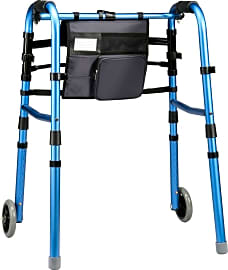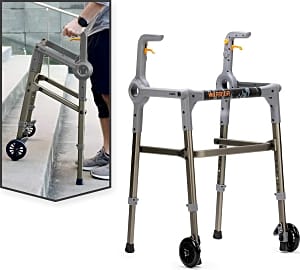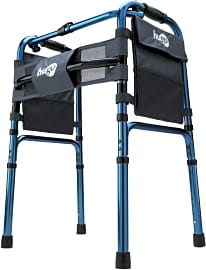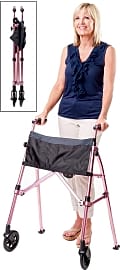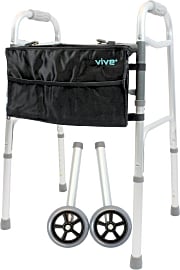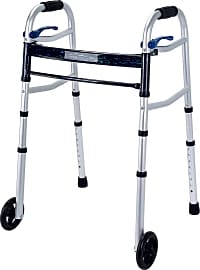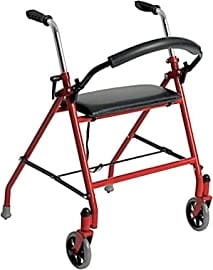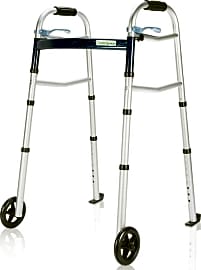The 10 Best 2-Wheel Walkers

This wiki has been updated 34 times since it was first published in April of 2016. Whether you require permanent assistance getting around due to a disability, chronic condition, or frailty, or you just need some temporary help following an injury or operation, check out these two-wheel walkers. They are specifically engineered to provide support for those who need a little more mobility than a standard walker can offer, but who don't want or need a four-wheeled rollator. When users buy our independently chosen editorial selections, we may earn commissions to help fund the Wiki.
Editor's Notes
July 03, 2020:
When selecting our two-wheel walkers, stability was a top priority, but it was also important to us that our choices were easy to use for those with dexterity issues, decreased strength, and other ailments from which those with mobility problems can suffer. We also looked for features that would minimize the inconveniences of taking a walking aid everywhere one goes.
On the topic of convenient features, we appreciated models with seats, like the Drive Medical 1239RD and the Nova Medical Products Cruiser II because, rather than becoming a bulky nuisance when the user gets to his or her destination, these offer a comfortable place to rest. They can almost replace the need for a folding chair when on the go. Even though the Acctrend 2 has a seat, we removed it as its metal bar that's meant to serve as a backrest is very uncomfortable.
We also liked models with storage, such as the Hugo Mobility 770-260, the Drive Medical Deluxe Portable, and the Vive Mobility Push Button. When using a walker, one might struggle to carry a purse or bag, so the addition of pouches on these is quite helpful.
Walkers that can fold up compactly also caught our attention, since it can be hard to find the space to store these items when not in use. The Roami Progressive 4-In-1 Mobility Aid got a spot because it can fold nearly completely flat, and the Stander EZ Fold-N-Go also caught our attention because it can be collapsed into a small size. We removed the Able Life Space Saver because it's nearly identical to the Stander EZ Fold-N-Go, while lacking the benefit of storage pouches.
The Drive Medical 10253-1 had to go too, as it can feel a bit wobbly, and stability is very important in these products. In its place came the durable OasisSpace Compact, which can support up to 350-pounds, and the Carex Health Brands Explorer, with its robust aluminum frame.
Special Honors
CardinalHealth Dual Button Folding Walker With 5 Inch Wheels The CardinalHealth Dual Button Folding Walker with 5 Inch Wheels comes in at a very fair price considering its 300-pound weight capacity, soft molded handgrips, and steel cross brace that offers rigidity. It has an anodized aluminum frame and slip-resistant PVC tips on the rear legs that offer an additional sense of stability. cardinalhealth.com
ProBasics Two-Button Folding Walker With Wheels And Roll-Up Seat The strong nylon seat on the ProBasics Two-Button Folding Walker with Wheels and Roll-Up Seat can support 300 pounds and provides a convenient place to rest when chairs aren't available. It has multiple height adjustment settings, folds flat for storage, and has user-friendly push-button mechanisms that allow one to operate each side independently. 1800wheelchair.com
What’s A Two-Wheel Walker?
There are many scenarios in which someone, young or old, might need a walker.
A walker is a mobility aid that keeps individuals from falling by helping them keep their balance. There are many scenarios in which someone, young or old, might need a walker. Someone who’s had leg surgery, for instance, may need to treat this weak leg carefully, using a walker to prevent re-injury. Others have balance issues, perhaps caused by medications or age. Arthritis also causes many individuals to reach for walkers.
As there are different reasons people need walkers, there are many different types available. The most common types are no-wheel, two-wheel, and four-wheel; those that have wheels may also be called rollators. The no-wheel type is the sturdiest, but they also require the most upper-body strength to maneuver because you have to pick them up and put them down with each step. Two-wheel walkers lessen the need for strength because they roll forward with the two front wheels; they also give stability thanks to the two back legs. Four-wheel walkers glide forward, but these are generally the least stable, as they rely on brakes to prevent accidental motion.
A variety of factors determine what kind of walker someone needs. The type of injury or condition, the price of the unit, and the type of terrain the person will traverse are all important factors to consider. In general, though, two-wheel walkers offer a good middle ground for many types of health issues, especially since some convert to no-wheel glide walkers. With these, you simply swap out the bottom portion of the front two legs.
Features Of Two-Wheel Walkers
Along with offering swappable legs, two-wheel walkers present a range of features that vary by model. For example, some models come in various colors, so why go with plain silver when you could have sleek blue or even pink? Other features, including the following, highly impact usability and comfort.
Some can handle up to 250 or even 300 pounds; any heavier, and you’ll most likely need a bariatric walker designed to accommodate up to 500 pounds.
First, two-wheel walkers are rated for various weights. Some can handle up to 250 or even 300 pounds; any heavier, and you’ll most likely need a bariatric walker designed to accommodate up to 500 pounds. Paying attention to this number is important for two reasons. One, too much weight could cause the walker to malfunction and harm the user, and two, usage outside of the manufacturer’s designations could void the unit’s warranty.
Next, the majority of two-wheel walkers are height adjustable, although to what degree may vary. You can see this information listed with the product details; look for “minimum handle height” and “maximum handle height.” Manufacturers generally also list the amount of space between the hand grips. Smaller individuals may not enjoy a walker that’s overly wide.
Then, a two-wheel walker may or may not have a seat. If the user walks long distances with the device, he or she may enjoy the ability to sit down and rest along the way. On the other hand, if the device is only for short trips, then a seat might be in the way.
Also, don’t forget about portability. There could be times when the walker needs to go in the trunk of a car or be stashed out of the way. For this, a foldable walker could be just the ticket. Think, too, about how much the unit weighs. If it’s heavy, it could be too difficult to pick up and transport.
Finally, look at all the little extra features that make the experience more enjoyable. These include handy storage bags that hang from the front or sides, comfort hand grips, and water bottle holders. And if there are many of these moving pieces or extras, can you buy replacements in case they wear out? Hopefully, you won’t ever need to, but accidents do happen, so you might check that you will have some recourse.
Using A Two-Wheel Walker
A two-wheel walker can make an individual with mobility problems safer, as long as he or she uses the walker correctly. Falls are still possible with improper use, which can occur because people assume a walker is an effortless device. You just put it in front of you and walk, right? In truth, there’s a little more to the technique than that. A few principles of good use will add to both safety and to the user experience.
A two-wheel walker can make an individual with mobility problems safer, as long as he or she uses the walker correctly.
Before you start to use a two-wheel walker, you need to make sure it’s at the right height. Experts suggest that when you are standing straight with your arms relaxed at your sides, the grip should meet the crease on your inner wrist. Stand like this and have a friend help you measure from your wrist crease to the floor if you need help choosing the correct two-wheel walker height.
When you start to use the walker, you’ll need to know how to stand up and sit down safely. To stand up, scoot forward until you’re at the edge of the chair, then push yourself up by holding the arms of the chair. Most experts suggest that you shouldn’t use the walker to pull yourself up, because this could lead to a fall. This principle, using the chair, applies when sitting down, as well. First, move back until the backs of your legs are touching the chair, then use your arms to help lower yourself. Don’t flop backward or pitch forward, either.
Walking with a two-wheel walker can take some getting used to, but essentially, you need to keep all four of its legs on the ground when you’re stepping and never get too far away or too close. That is, don’t thrust it way out in front of you and don’t stand right up against the front bar. Try to look up and not at your feet for the best balance and posture. Keep hazards out of the way; you can prevent injury by removing loose rugs and cords.
Remember, too, that these are guidelines. Each person has individual challenges and should listen to the advice of his or her doctor or physical therapist.


